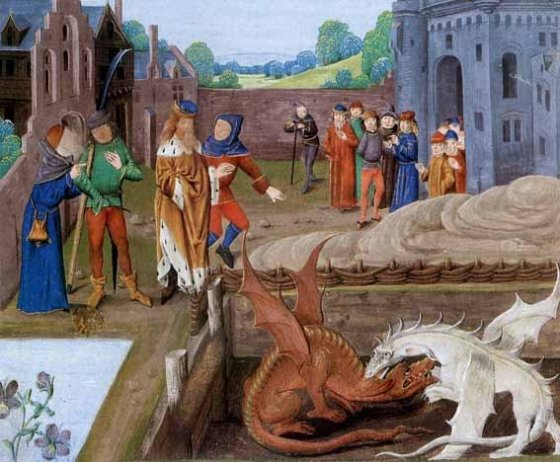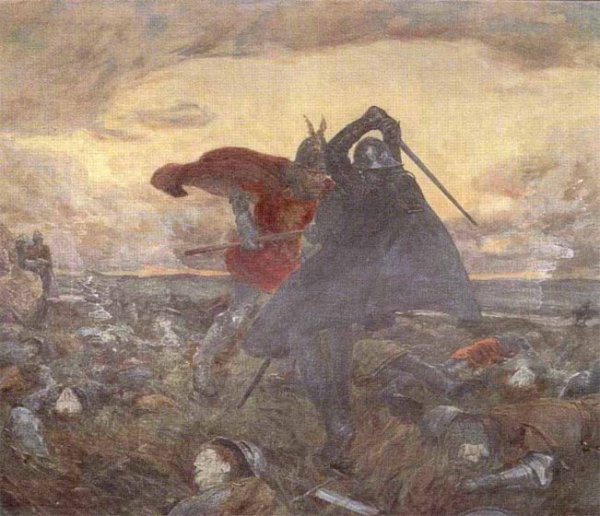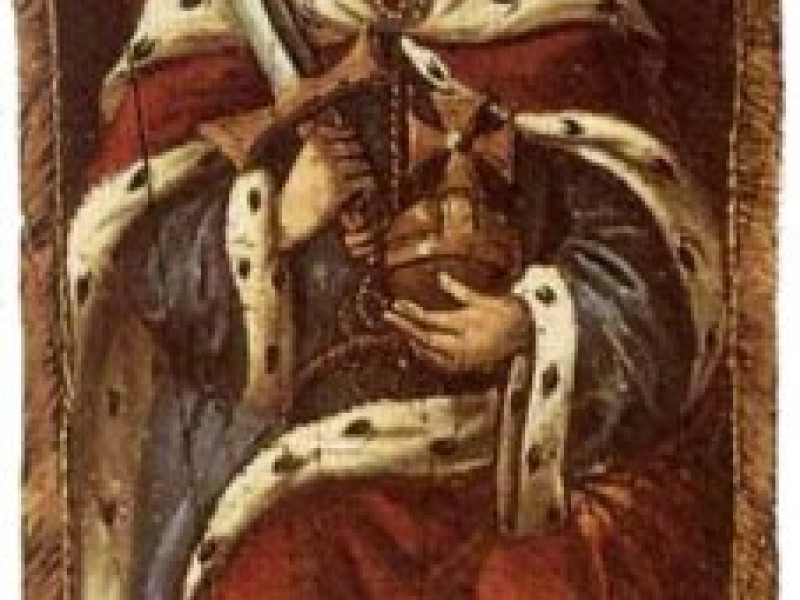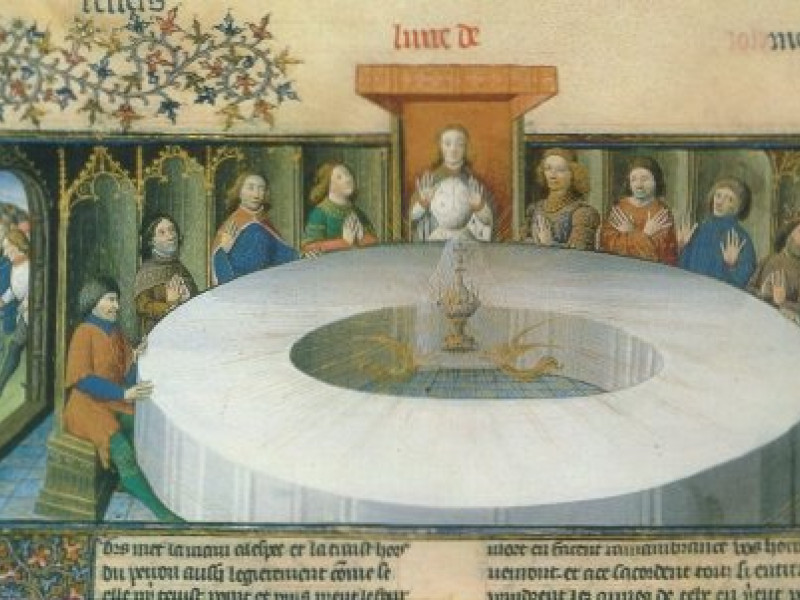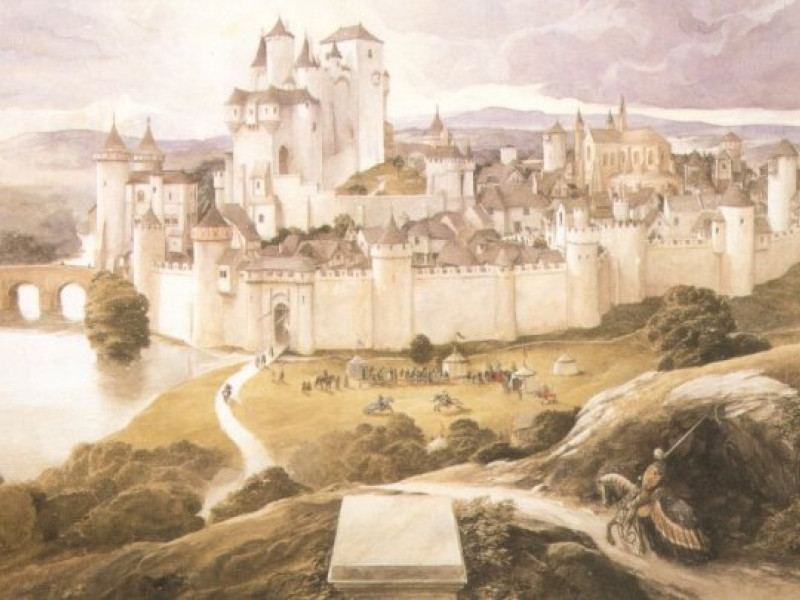Life of King Arthur
Here, I will give a brief treatment about the life of King Arthur. My sources below are some of the earliest accounts of Arthur, written by three different authors: Geoffrey of Monmouth, Wace and Layamon.
Geoffrey of Monmouth was a Welsh writer who flourished in the first half of the 12th century. Although there were earlier sources for Arthur in Welsh legends, it wasn't until Geoffrey wrote the Historia regum Britanniae ("History of the Kings of Britain", in Latin, 1137), that we have a full account of Arthur's life. This so-called history of Britain began with Brutus, grandson of the Trojan hero Aeneas, who migrated to the British Isles, to the time of Cadwallader, when the Saxons conquered the Britons. Geoffrey also wrote Vita Merlini (Life of Merlin) in 1151 and the "Prophecies of Merlin" in 1155 (see Merlin). It is clear that Geoffrey used many Welsh and Breton sources to create Historia.
Wace was an Anglo-Norman author who wrote the Roman de Brut, in 1155. Wace's Roman de Brut was a French adaptation of Geoffrey's Historia regum Britanniae, so it was not a full translation of Geoffrey's work. Wace's work varied to some degree, adding details and events to Geoffrey's history. Wace was the first to introduce the knightly fellowship of the Round Table to the account of Arthur. It was Wace's work on Arthur which spread the popularity of the legend in French and Anglo-Norman courts, where a new genre of literature was soon developed by Chretien de Troyes, the father of medieval (Arthurian) romances.
Layamon was an English author who wrote Brut, in c. 1200. Brut was adaptation of Wace's work into English. Layamon also added more details to Wace and Geoffrey's works. Layamon's Brut took on a more supernatural dimension, where fairies play some roles in Arthur's life.
I have relied on these three writers for the early traditions, ignoring all other writers. Alternative accounts can also be found on a number of different pages, and my main sources come from the Vulgate Cycle and the Post-Vulgate Cycle. See the Vulgate Cycle for the alternative accounts.
In the Vulgate Cycle, you will find that I have divided the legend of Arthur and the Grail into four separate pages. You will find that Arthur's birth and his early rise to power on the page called Legend of Excalibur. Arthur's role is minor in the Lancelot and Grail page. Arthur played a more prominent role in the last page called the Death of King Arthur.

House of Constantine
Vortigern
Death of Constans
Before Arthur was born, the Britons were living under the constant threat of Saxon invaders. Arthur belonged to the House of Constantine, in which Constantine was Arthur's grandfather. Constantine was the king of Britain or Logres (much of England and Wales). Constantine was the father of Constans, Aurelius Ambrosius, and Uther.
(Please note that in the Old French literature, the sons of Constantine were named Maine (Constans), Pendragon (Aurelius Ambrosius) and Uther. Maine means monk, because Constans would have taken a vow, had his father had not died. The name Ambrosius disappeared in the French version, while Uther Pendragon was divided into two names for the two younger brothers.)
When Constantine died, the king's council was deciding who would rule the Britons, Aurelius or Uther, because Constans - the eldest - was to become a priest. One of the councillors, named Vortigern, wanted Constans as king. Vortigern took Constans from the church and made the young man king.
Constans was a weak and naive king, relying heavily on Vortigern's treacherous advice. Vortigern became his most powerful adviser. Constans gave Vortigern so much power that he was king all but in name.
Vortigern duped some Pictish mercenaries to murder his king. Vortigern killed the Picts, and then seized the throne. The foster-parents of Constans' brothers, fearing for the young princes' lives, spirited Aurelius and Uther to Brittany (called Armorica at the time) to live with their uncle.
The Coming of the Saxons
During Vortigern's reign, a group of Saxons came to Britain. Vortigern welcomed the Saxons, led by Hengist (Hengest) and Horsa. The king used them as mercenaries against the Pictish revolts up in Scotland. Vortigern fell in love with Rowenna, Hengest's beautiful daughter, and married her. Vortigern's new father-in-law became his powerful adviser, counselling the king to allow more of his Saxon relatives to immigrate, in increasing numbers.
Vortigern's Briton advisers became alarmed at the thousands of Saxons settling in Britain. Even Vortigern's own sons opposed the Saxon settlers. Vortimer, Vortigern's eldest son, led the Britons to a revolt and deposed his father as king. Rowena duped her stepson (Vortimer) into drinking poison.
The war between Britons and Saxons continued, until Hengist advised Vortigern that he would accept a truce. Before a treaty could be signed, the Saxons pulled out knives and massacred the Briton nobles. Hengist treacherously deposed his son-in-law as king of Logres, and Vortigern fled to Wales.
The Britons were helpless against the Saxons, who looted, raped and killed the Britons. Churches and towns were destroyed.
The Boy Prophet
In Wales, Vortigern decided to protect himself by building a castle on Mount Erith, but every night the walls would crumble the next day. Merlin, the son of a princess (now a nun) and an incubus (male demon), told him why the foundation kept causing the walls to collapse. (A more detailed account of Merlin's birth can be found in the Prose Merlin (c. 1240, Vulgate Cycle). See Son of the Devil on the Merlin page for this version of his birth.)
Merlin became a prophet and Vortigern's adviser. Merlin foretold Vortigern's death, and those of the next kings - Aurelius and Uther. Merlin also prophesied that a king (Arthur) would be born out of a dragon (Uther), and he would rule the world, bringing a period of renaissance to the Britons. However, Merlin foresaw that the Saxons would return and conquer the Britons.
Related Information
Sources
Historia regum Britanniae ("History of the Kings of Britain", c. 1137) and
the Vita Merlini ("Life of Merlin", c. 1152) were written by Geoffrey of Monmouth.
Wace wrote Roman de Brut ("Story of Brutus"), c. 1155.
Layamon wrote Brut, c. 1200.
Historia Brittonum was written by Nennius (8th century).
De excidio et conquestu Britanniae ("The Overthrow and Conquest of Britain") was written by Gildas, before AD 570.
Historia ecclesiastica gentis Anglorum ("Ecclesiastical History of the English People") was written by St Bede the Venerable, in 732.
Related Articles
Aurelius Ambrosius
Aurelius Ambrosius and Uther had been raised in Brittany since Vortigern was in power in Logres (Britain). When the brothers reached manhood, they gathered a large army from Brittany to avenge their brother's death (Constans) and drive out the Saxons.
First, they turned their attention to Vortigern, who had fled to his palace. The brothers set Vortigern's palace on fire, burning Vortigern to death. Aurelius became king, and fought a series of battles against the pagan Saxons. Horsa was killed in battle, while Hengist was captured and then executed.
Aurelius continued the war against the remaining Saxons led by Hengist's son, Octa. Octa was defeated and allowed to settle in Scotland. Aurelius Ambrosius set about rebuilding his kingdom.
It was said that under Merlin's advice, he built the giant stone ring known as the Giant's Ring, or more commonly as Stonehenge, by bringing large rocks from Ireland.
When Aurelius Ambrosius was poisoned during the war against Paschent (Vortigern's son), he was buried within Stonehenge.
Related Information
Sources
Geoffrey of Monmouth wrote Historia regum Britanniae ("History of the Kings of Britain", c. 1137) and
the Vita Merlini ("Life of Merlin", c. 1152).
Wace wrote Roman de Brut ("Story of Brutus"), c. 1155.
Layamon wrote Brut, c. 1200.
Historia Brittonum was written by Nennius (8th century).
De excidio et conquestu Britanniae ("The Overthrow and Conquest of Britain") was written by Gildas, before AD 570.
Historia ecclesiastica gentis Anglorum ("Ecclesiastical History of the English People") was written by St Bede the Venerable, in 732.
Related Articles
Uther Pendragon
The Sign of the Dragon
Uther found out from Merlin about his brother's assassination, when he was on campaign against Paschent (Vortigern's son) and Gillomanius, king of Ireland. Uther and Merlin saw a strange phenomenon in the night sky. They a comet streaking past two dragons flying in the night sky. Thereafter, the new king was named Uther Pendragon.
Uther won a decisive battle at Menevia. Gorlois, the middle-aged duke of Cornwall, was the man who devised a strategy to defeat Paschent, and brought a great victory to Uther. Paschent and Gillomanius were killed in battle.
Birth of Arthur
During the victory celerbration in London, Gorlois brought his young and beautiful wife named Igraine. Uther fell instantly in love with the duke's wife. Uther was so obvious about his lust that Gorlois left the celebration in disgust with his wife, without asking for the king's leave.
Uther threatened war with Gorlois. The old duke ignored the king's warning, and returned to Cornwall to organise his defence. Since Tintagel was his strongest castle, he left his wife there, while he went to fortify his other castle. Uther pinned Gorlois inside this besieged castle.
With the help of Merlin's magic, Uther took the form of Gorlois in appearance, while Merlin transformed himself into Gorlois' steward (Britael) and Ulfin was transformed into Gorlois' chamberlain (Jordan). Uther secretly went to Tintagel with Merlin and Ulfin under these guises, and entered the castle.
Everyone in Tintagel thought Uther was Gorlois, even Igraine. Uther slept with his enemy's wife, and Arthur was conceived. That very night, news reached them that the real Gorlois had been killed in the siege of the other castle. Uther falsely convinced the people of Tintagel that he (Gorlois) was alive. He pretended to return to his other castle, but actually he returned to his own army, in his own form.
Uther then learned that the news of Gorlois' death was true. Uther ordered all of Cornwall, including Tintagel, to surrender. Igraine, realising that her husband was dead, surrendered the duchy to Uther. Uther was still in love with Igraine; the king immediately married her the next day. Igraine was already pregnant with Arthur. A year after Arthur was born; Igraine gave birth to a daughter named Anna. According to Layamon, Arthur received many magical gifts from the fairies. They gave him the gift of courage, strength, wisdom, kingship, and long life.
Death of Uther
Over ten years after Arthur was born, Uther faced another war against Octa (Hengist's son), who left his exile in Scotland and attacked Logres. Octa was aided by Colgrim (Colgrin), king of the Saxons in Germany. Uther was ill at the time. Uther left the command of his army to Lot, whom his daughter, Anna, had married. Lot and Anna were parents of two sons - Gawain and Mordred. However, Lot was losing more battles than he was winning. So the ill and weary king went into the battle. With Uther in command, Octa and his cousin Eosa were defeated and killed in the battle at St Albans.
Colgrim escaped at fled to York, where he rallied his forces.
Later, spies of Colgrim poisoned the water in the well that Uther normally drank. Many people in Uther's household died from the poison, including Uther. Uther was buried beside his brother, at the Giant's Ring (Stonehenge).
Related Information
Sources
Geoffrey of Monmouth wrote Historia regum Britanniae ("History of the Kings of Britain", c. 1137) and
the Vita Merlini ("Life of Merlin", c. 1152).
Wace wrote Roman de Brut ("Story of Brutus"), c. 1155.
Layamon wrote Brut, c. 1200.
Historia Brittonum was written by Nennius (8th century).
De excidio et conquestu Britanniae ("The Overthrow and Conquest of Britain") was written by Gildas, before AD 570.
Historia ecclesiastica gentis Anglorum ("Ecclesiastical History of the English People") was written by St Bede the Venerable, in 732.
Related Articles
Rise of King Arthur
Kingship of Arthur
Arthur became king of Britain after his father's death. For some reason, Arthur was raised in Brittany, living with his Breton relatives. Arthur set about driving the Saxons out of Logres. Arthur gathered his large army of Britons, campaigning against Colgrim and his brother Baldulf. Cheldric, emperor of the Germans, aided Colgrim. Colgrim also forced the Scots and Irish to fight against Arthur. Outnumbered, he sent forth a request for aid from Hoel (Howel), his cousin from Brittany.
Arthur's sword, Caliburn, was mentioned for the first time. Later writers called the sword, Excalibur. Caliburn was a gift from Avalon. Layamon gave other names to Arthur's armour and weapons, saying that fairy (elf) smith made Arthur's byrnie (coat of mail).
With his army, Arthur went to relieve the siege at Bath. In the battle, Arthur single-handedly killed Colgrim and Baldulf. Cheldric fled with very few survivors to the hill called Teignwick or the Isle of Thanet. Cador, Arthur's chief adviser and duke of Cornwall, pursued and killed Emperor Cheldric.
(Note that Geoffrey identified the battle of Bath with that of the historical(?) battle of Mons Badon).
Arthur then went about on a series of campaigns to punish all those who had supported the Saxons. Arthur brought his army to Scotland. The Scots offered no resistance; they told Arthur that the Saxons had forced them to side with them. The Scots declared Arthur as their ruler and paid homage to him.
Three brothers - Urien, Auguselus (Angel) and Lot had previously ruled Moray, Scotland and Lothian before the Saxons took over. Arthur restored these kingdoms to the brothers. Lot was Arthur's brother-in-law, who had married Arthur's sister Anna. Lot had two sons (according to Geoffrey, Wace and Layamon), named Gawain (Gualguanus in Geoffrey's "History") and Mordred.
When Arthur was wintering in Cornwall, the king met Guinevere (called Guanhumara by Geoffrey), ward of Cador, a young and beautiful woman, who was descended from a noble Roman family.
From Scotland, Arthur's next campaign took him to Ireland, to punish their king (Gillomanius) for siding with the Saxons during the war. Arthur defeated the Irish army and captured the king. Gillomanius was restored to his throne in return for becoming a vassal to Arthur.
Iceland, Orkney, and Wendland (Germany?) fell to Arthur without fighting. Their kings welcomed Arthur, and willingly became his vassals.
Related Information
Sources
Geoffrey of Monmouth wrote the Historia regum Britanniae ("History of the Kings of Britain", c. 1137).
Wace wrote Roman de Brut ("Story of Brutus"), c. 1155.
Layamon wrote Brut, c. 1200.
Historia Brittonum was written by Nennius (8th century).
Contents
Kingship of Arthur
Round Table
Conquests in Norway and France
Round Table
Geoffrey of Monmouth wrote that Arthur established a plenary court held on every Whitsuntide, in the City of Legion, on the river Usk (in Wales). There, all his vassals attended, including British and foreign nobles. As well as establishing policy for his growing empire, there were great festivities.
According to Wace and Layamon, fighting erupted between the nobles over the seating arrangements. Every king and baron wanted to be seated at the head of tables or near Arthur, so that they could establish themselves as having precedence over others. Barons were feeling envy or jealousy to those of high ranking, for each one thought they were superior over others.
To resolve these problems, Arthur had a large, round table constructed. Arthur also had every seated member of the Round Table, served at the same time. The ingenuity of this design made all of the knights equal, regardless of if one was a king or a minor baron. Thus, no one would have precedence over others. The writer Wace first introduced this episode of the fellowship of the Round Table, while Layamon expanded the legend surrounding this fellowship. Layamon wrote that the table could be folded up and taken anywhere Arthur decided to hold court.
Later legends, such as Boron's trilogy and the Vulgate Cycle, said that it was Merlin who thought of the design and created the Round Table, which soon became associated with the quest of the Holy Grail.
Related Information
Sources
Geoffrey of Monmouth wrote the Historia regum Britanniae ("History of the Kings of Britain", c. 1137).
Wace wrote Roman de Brut ("Story of Brutus"), c. 1155.
Layamon wrote Brut, c. 1200.
Historia Brittonum was written by Nennius (8th century).
Contents
Conquests in Norway and France
Arthur's next campaign was in Norway. Arthur decided to make his brother-in-law King Lot king of Norway. The Norwegians, however, had other ideas. Their king, named Riculf, gathered a large army and met with Arthur's army. The Norwegians were defeated and Riculf was killed. Arthur then established Lot as their new king.
Then Arthur turned his attention south, conquering Denmark, before arriving in Gaul (France). The Roman emperor Leo ruled Gaul. Arthur promptly defeated the weak army under the command of Frollo, the Roman governor. Frollo fled to Paris, and Arthur besieged the city. Realising the city couldn't hold out in a long siege, Frollo challenged Arthur to single combat; the victor would have Gaul. Though Frollo wounded the British king, he was killed. Paris surrendered to Arthur. Other regions of France also fell into his domination.
Arthur gave Kay, the seneschal, the region of Anjou, while Bedivere, his cupbearer, received the province of Neustria (Normandy). He distributed other regions of France to his other followers. Arthur stayed in Gaul for nine years before returning home.
Related Information
Sources
Geoffrey of Monmouth wrote the Historia regum Britanniae ("History of the Kings of Britain", c. 1137).
Wace wrote Roman de Brut ("Story of Brutus"), c. 1155.
Layamon wrote Brut, c. 1200.
Historia Brittonum was written by Nennius (8th century).
Contents
Kingship of Arthur
Round Table
Conquests in Norway and France
Death of King Arthur
War Against Rome
At Whitsuntide, in the kingdom of Logres, Arthur held a plenary court at Caerleon (Caerleon-upon-Usk), where he wore the crown of the kingdom. All his vassals, British and foreign lords, attended. The festivities lasted for three days.
On the fourth day, twelve elderly men arrived from Rome, with a message from Lucius Hiberius, the Roman procurator and general (emperor according to some writers). Lucius demanded tribute from Arthur and the return of Gaul (France) to Rome. Arthur sent the messengers back to Rome. His reply was that he would pay his tribute to Rome by the body of Lucius Hiberius.
Arthur gathered a huge army, leaving his nephew Mordred in charge of Britain and his wife, Queen Guinevere.
The army met the fleet at Southhampton, where they embarked. They landed at Barfleur. Arthur then heard news that his niece Helena had been abducted by a giant from Spain. The giant took her to Mont-Saint-Michael. Helena was the daughter of Duke Hoel of Brittany. Arthur decided to confront the giant, taking only Kay and Bedivere with him. They met an old woman who was a nurse to Helena. The nurse warned Arthur of how Helena died of fright, so the giant raped the old woman instead.
When the giant appeared, Arthur sprung into action and attacked the monster with his sword and shield. The giant, armed with a club, attempted to bash his smaller but more agile enemy. Arthur managed to blind the giant by striking his forehead; the blood ran into his eyes.
Avoiding the wildly swinging club, Arthur then dealt a mortal blow, driving his sword through the giant's head. The giant toppled over with a crash. With the giant dead, the king ordered Bedivere to take the monster's head so they could return to the army with a trophy of his victory.
Arthur's buried his niece at Mont-Saint-Michael, where it was named Helena's Tomb.
Arthur moved his army to Autun, and sent his nephew Gawain along with Boso of Oxford and Gerin of Chartres (from Charlemagne's Twelve Peers) as ambassadors to Lucius.
They arrived at Lucius' camp to order the Roman army to withdraw from Gaul or face the might of Arthur and the Britons. Gawain became furious when Gaius Quintillanus, the nephew of Lucius, insulted the Britons, calling them braggarts rather than real warriors. Gawain answered the insult by swiping off Gaius' head with his sword. Fighting immediately broke out in the Roman camp. Gawain and his companions managed to escape to their horses with the Romans in pursuit.
Soon, the fighting spread as the skirmish turned into a full-blown battle. The battle swung in favour of the Britons, then the Romans, and then back again, throughout the bloody day.
In the fierce battle of Saussy, causalities were very high on both sides. Among the dead was Bedivere, the Cupbearer of Arthur. Bedivere was killed by King Bosus of the Medes. Bosus had also mortally wounded Kay. Hyrelgas avenged his uncle Bedieve by killing Bosus, before chopping the Median king to pieces.
Gawain fought Lucius in single combat, until the Romans rescued the general. When the Romans were defeated, they found that some unknown warrior had killed Lucius Hiberius. (In the Vulgate Merlin, Gawain had killed Lucius, while later legends said that Arthur fought and killed Lucius.)
Even though Arthur won a great victory over the numerically superior Romans, their losses were also great. Arthur told the captive Romans to return the body of Lucius Hiberius to the Senate, and that this was his payment of his tribute to Rome.
Note that the Vulgate Cycle, Thomas Malory's Morte d'Arthur and other works were different from what is told here. Compare this with war against Rome in the Mort le Roi Artu of the Vulgate Cycle.
Related Information
Sources
Geoffrey of Monmouth wrote the Historia regum Britanniae ("History of the Kings of Britain", c. 1137).
Wace wrote Roman de Brut ("Story of Brutus"), c. 1155.
Layamon wrote Brut, c. 1200.
Contents
War Against Rome
Battle of Camlann
Battle of Camlann
Before Arthur could march to Rome with his army, Arthur heard news that his nephew Mordred had committed treason by seizing power in Logres (Britain) and proclaiming himself as king. To add salt to the wound, Mordred wedded Arthur's wife (Guinevere). According to Wace, Guinevere was forced into the marriage with Arthur's nephew. Geoffrey and Layamon said that Guinevere had treacherously betrayed the king and had willingly married the king's nephew.
Mordred enlisted help from the Saxons, the Britons' long time enemy. Mordred promised them land, if Chelric helped him in the war against Arthur.
Arthur had to divert his army towards Logres and put down Mordred's rebellion. Leaving Hoel behind in Gaul, Arthur immediately departed for Britain. Mordred, hearing the news, brought a large army to face Arthur's in Richborough. A great deal of Arthur's men were killed, trying to land at Richborough, before the tide turned to Arthur's favour. Seeing that this battle was lost, Mordred fled to Winchester. Among those killed in the battle was Auguselus, king of Albany (Scotland), and Gawain, who was cut down by his own brother.
Guinevere fled from either Mordred or Arthur to the City of Legion or Caerleon, where she secretly entered the abbey and became a nun.
When Arthur besieged Mordred at Winchester, his nephew secretly escaped to Cornwall. Arthur pursued his nephew and met him at Camlann (Camblam, Camelford, Camble or Salisbury Plain, depending on the authors).
It seemed that Arthur won the battle at a great cost. Though all of the leaders on Mordred's side were killed, the rest fled from the field of battle. This would normally be taken as a victory. Wace did not mention any survivors on either side.
Arthur and Mordred faced one another. Arthur killed his nephew, but the great king received a mortal wound from Mordred. All three authors say that Arthur went to have his wounds healed at Avalon, and left the kingdom to Constantine, the son of Cador of Cornwall, to rule in AD 542.
According to a later work by Geoffrey of Monmouth called Vita Merlini (the "Life of Merlin", 1150), Arthur was taken to the Isle of Avalon after the battle by the bard and seer, Taliesin, and Barinthus, pilot of the ship. In Avalon, Arthur would be healed by Morgan and her eight sisters. Here, there was no indication that Morgan was his sister.
Wace hinted that Arthur would return to Britain one day. Layamon said that Arthur had received fifteen wounds, and that two women came to him from a boat. They took Arthur to Argante, the beautiful elf queen of Avalon, who would heal him. Could this Argante be another name for Morgan le Fay?
There are many variation of Arthur's death. If you want to compare this version with that of Mort le Roi Artu (c. 1230) from the Vulgate Cycle, then read Infidelity and Betrayal and Twilight of the Kingdom.
(Did you notice that I did not mention Arthur ordering his companion to throw his sword (Excalibur) into the water? This episode about the sword belonged to the later, alternative tradition. See the Death of King Arthur (Vulgate Cycle). I also included Sir Thomas Malory's version in that page.)
Related Information
Name
Camlann (Welsh).
Camblam (according to Geoffrey),
Camble (according to Wace),
Camelford (according to Layamon).
Salisbury Plain (in Vulgate Cycle).
Sources
Geoffrey of Monmouth wrote the Historia regum Britanniae ("History of the Kings of Britain", c. 1137).
Wace wrote Roman de Brut ("Story of Brutus"), c. 1155.
Layamon wrote Brut, c. 1200.
Contents
War Against Rome
Battle of Camlann
Epilogue
Before I begin the next section about the legend of Arthur, there are a few words I would ike to say.
The legends of King Arthur were the product of progressive cycles of adding new materials by different authors. One thing you must understand about legends (including myths) is that no one author will tell all of the stories.
Even in the early accounts, it was different. Take the Round Table for instance. Geoffrey of Monmouth made no reference to the Round Table. It was Wace who introduced the Round Table into the legends. Layamon expanded on how the Round Table was created and gave more details about the fellowship of the Round Table.
Wace did not fully translate Geoffrey's Historia regum Britanniae from Latin to French. Wace left some stuff out as well as adding new material to the legends. Similarly, Layamon's Brut was more of an English adaptation than a literal translation of Wace's work.
Notice that there were no references to Lancelot, Galahad or Perceval in the early accounts; Arthur's main knights in this legend were Kay and Bedivere. Nor was there the legendary city called Camelot; Arthur's capital seemed to be Caerleon-on-Usk in the early traditions. Nor was there any reference to Arthur drawing Excalibur out of the rock or throwing Excalibur in the water. The Grail legend also never existed until Chretien de Troyes wrote the first tale about it.
So if you wish to read about Arthur drawing the sword from a rock or fetching it from the lake, the adultery of Lancelot and Guinevere, the quest of the Grail and the different versions of Arthur's death, then you should go to the page called Vulgate Cycle.
The Vulgate Cycle will provide you with an alternative version of the life of King Arthur, through the use of alternative sources. These sources come mainly from tales that belong to the Vulgate Cycle and the Post-Vulgate Cycle.
Related Information
Related Articles
Arthur, Lancelot, Perceval, Galahad.
Historical Background, Vulgate Cycle (alternative account of King Arthur).
Genealogy
House of King Arthur (Geoffrey's version)
Related Pages
By Jimmy Joe
